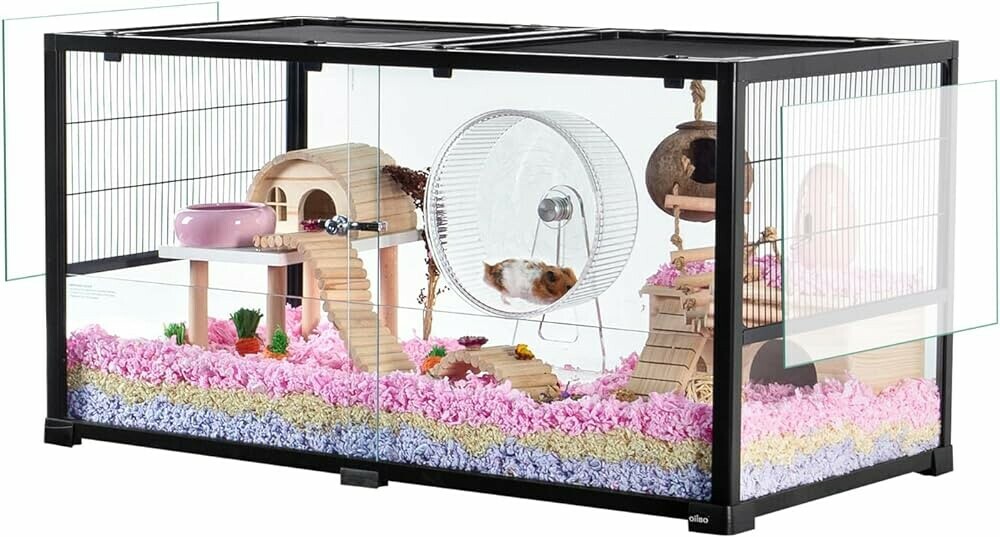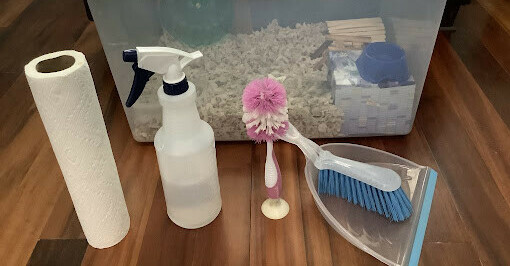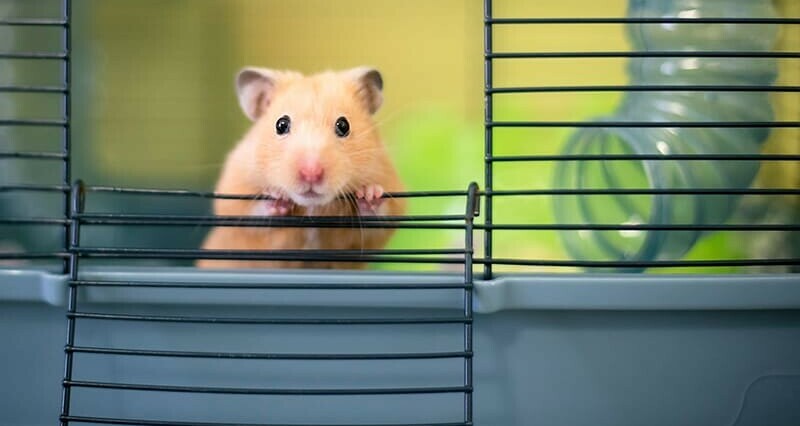Understanding the importance of proper ventilation in hamster cages is crucial for maintaining your pet’s health and well-being. Let’s take a closer look at why this aspect of pet care should never be overlooked.
Respiratory issues can be quite common in hamsters, and they’re not something to take lightly. A cage that’s lacking in airflow allows harmful gases like ammonia, which comes from urine, along with dust from bedding and mold spores, to accumulate. This can turn your hamster’s home into a hazard zone pretty quickly. That’s why ensuring fresh air circulation is a non-negotiable for your little friend.
Humidity levels are another concern. If the air in the cage can’t circulate properly, humidity can skyrocket, creating an unwanted spa day every day for bacteria and mold. And trust me, this is one kind of moisture that’s not beneficial for your hamster’s skin or health.

Ventilation isn’t just about keeping the air moving; it’s also about temperature control. As temperatures rise, so does the risk of overheating for your furry pal. A well-ventilated environment helps to maintain a cooler and more stable climate in your hamster’s living quarters, even when it’s sweltering outside.
Now, consider the odors in your hamster’s cage. Without proper ventilation, your home could start to take on the eau de hamster aroma, and not in a good way. Good airflow helps to whisk away those ‘natural’ smells, making the habitat more pleasant for everyone involved.
And let’s not forget the ammonia buildup. Hamster urine contains ammonia, and without ventilation, the levels can get higher than what’s safe for your pet, potentially leading to respiratory tract damage. That’s a scenario we want to avoid at all costs.
This is more than just ensuring your pet has a gentle breeze; it’s about creating a safe, healthy home. With each of these points in mind, you’re on your way to understanding the comprehensive benefits of ventilation for your hamster’s health.
But what does it really take to design an optimal hamster cage environment that supports all these needs for airflow, clean air, and a safe habitat? That’s what we’re going to explore next. I’ll help you navigate the factors that influence ventilation requirements and provide tips to ensure that your hamster’s home is as welcoming as it can be, in our upcoming section.

Blueprint for Freshness: Designing the Optimal Hamster Cage Environment
I’m here to help you with designing the perfect habitat for your furry friend that goes beyond cuteness and comfort; it’s also about ensuring their health with the right ventilation. Let’s start with the basics – your choice of cage material.
Wire cages are often the go-to for hamster owners. They’re pretty much the gold standard when it comes to airflow. If you’re leaning towards a glass aquarium or a plastic bin, then you’ll need to get creative to ensure enough fresh air gets through.
Size matters too. You might think bigger is always better, and you’re not wrong. Larger habitats, while excellent for play and exercise, require a more strategic setup to maintain sufficient air exchange.
Now, how the bars are spaced on a wire cage plays a pivotal role in ventilation. Too narrow, and you restrict airflow; too wide, and you could have an escape artist on your hands. Aim for a sweet spot that combines safety with good ventilation.
And if you have a little hamster family, the more the merrier, right? Well, this isn’t just about space; it’s also about air. More hamsters mean more ammonia and odors, making effective ventilation even more crucial.
Lastly, think about where you live – because your hamster does, too. Hot and humid? You’re going to need to maximize ventilation. Somewhere cooler? Your ventilation needs might not be as intense but still vital for your hamster’s environment.

Strategic Positioning: Enhancing Airflow in Your Hamster’s Home
Understanding the importance of airflow doesn’t end at cage selection; where you place your hamster’s home can significantly impact the ventilation effectiveness. Let me walk you through some considerations for strategic cage positioning to keep your hamster happy and healthy.
You want to situate the cage in a spot that’s free from stagnant air but also shield it from harsh direct sunlight that can raise temperatures too high for comfort. Near a window is a good option, as long as there’s a way to provide shade during the brighter, hotter parts of the day. Fresh air exchange is crucial, yet you want to prevent exposing your furry friend to the intense sun.
Placing the cage in an open area can enhance ventilation from all sides. It’s like giving your hamster a breath of fresh air from every direction. But keep in mind, airflow is key, so avoid corners or enclosed spaces where air can’t circulate freely.
Elevating the cage on a stand is another smart move. It not only gives you easier access for cleaning and interaction but also promotes airflow beneath and around the cage. Think of it as creating a little breeze for your pet without resorting to artificial means.
Protecting your hamster from drafts is vital since sudden chills can be as harmful as stagnant, hot air. Finding a sweet spot where the ambient room temperature remains stable is going to prevent those drafts and help with overall temperature regulation within the habitat.
Remember, the climate you live in will also play a role in how you position the cage. In hotter and more humid climates, you’re going to need maximum ventilation to keep conditions comfortable. If you’re dealing with chillier surroundings or seasonal cold spells, be cautious about over-ventilation which could make your hamster too cold.

Ventilation Vigilance: Regular Maintenance for a Happy Hamster
I’m going to let you in on something important: keeping your hamster’s home in tip-top shape requires vigilance, especially when it comes to ventilation. Regular cleaning and maintenance are hands down one of the best ways to support the airflow your little companion needs. Without it, you’re looking at an increase in moisture and unwelcome odor — no one wants that.
Soiled bedding isn’t just unsightly, it’s a battleground for ammonia and an invite for mold and mildew. Staying on top of it by removing damp, dirty bedding promptly keeps the air moving correctly through the cage. Fresh, dry materials replace what’s been taken out, and just like that, you’re avoiding the risk of contaminants blocking your carefully crafted airflow.
Choosing a cage that simplifies your cleaning routine is a wise move. Look for the best ventilated hamster cages that offer easy access to all corners. And don’t forget, ease of maintenance means you’re more likely to stick with a regular cleaning schedule. Proper ventilation doesn’t just hinge on initial cage design; it’s kept up through consistent upkeep.
I really hope that you embrace a maintenance routine. That involves regular checks and swaps of environmental elements such as bedding and toys. Plus, wiping down surfaces ensures nothing gets in the way of fresh, clean air reaching your pet. Remember, a vigilantly maintained habitat is your frontline defense in promoting a healthy and happy hamster.
Now, all this maintenance serves a greater purpose than just preventing a stuffy cage. Your hamster’s activity levels, health, and overall joy are profoundly influenced by their living conditions. Pay close attention, because we’re moving on to some golden nuggets about how proper cage airflow keeps your furry friend frolicking and fit.

Ventilation Victory: Keeping Your Furry Friend Active and Content
I’m going to let you in on a little secret: the air your hamster breathes is just as essential to its happiness as the food it eats or the wheel it runs on. A well-ventilated habitat doesn’t just ward off potential health issues; it invites your furry friend to thrive, explore, and play in a setting that feels just right.
You’re going to find out that a hamster with access to fresh, clean air is more likely to show enthusiasm for its daily activities. This isn’t just about preventing health problems; it’s also about enriching your pet’s life. Picture your hamster, full of vigor, zipping through tunnels and perched alertly atop its favorite lookout – that’s the ultimate goal.
In my opinion, observing your hamster’s behavior is a fascinating way to gauge the efficacy of your ventilation efforts. If you notice your little pal seems more active, more curious, and perhaps even more social, you’re on the right track. Just don’t focus too much on perfection; instead, aim for consistent improvement in creating a safe and inviting habitat.
Maintaining a well-ventilated cage will bring about a tremendous payoff in the long term. Not only are you ensuring that your hamster is breathing air free from contaminants, but you’re also shaping an environment that supports its natural tendencies and zest for life. Choose a ventilation setup that resonates with you, one that makes keeping your hamster’s home fresh a simple part of your regular routine.
I really hope that you’ve gained valuable insight from our discussion on hamster cage ventilation. Remember, your first attempt at optimizing your hamster’s habitat for airflow might not be perfect, but you can always adjust your approach down the road. With these tips in mind, I’m confident you’ll create a sanctuary that keeps your hamster healthy, happy, and ready for every new day. That’s a victory worth celebrating!


2 replies on “The Importance Of Proper Ventilation In Hamster Cages”
Thank you for this thorough guide, it’s helped me to understand better how proper airflow can significantly impact a hamster’s health and overall well-being. I didn’t know about strategic cage placement and the importance of regular maintenance to ensure a healthy environment so thank you for that.
Could you provide more specific recommendations on how to create adequate ventilation for hamster cages made from glass aquariums or plastic bins? Is it similar to what’s required when you use a wired cage or is the process for providing good ventilation different, and if so what do I need to do?
Hi James, thank you for asking.
Creating adequate ventilation for hamster cages made from glass aquariums or plastic bins is definately crucial for the health and well-being of your hamster. Ventilation in these types of enclosures is a bit different from wired cages and requires careful consideration to ensure fresh air circulation. Here are some specific recommendations that I hope can help you:
Glass Aquariums
Lid Design: Use a secure mesh or wire lid instead of a solid one. The mesh should be fine enough to prevent your hamster from escaping but allow for plenty of airflow.
Size of Mesh: Ensure the mesh has small enough gaps (about 1/4 inch) to prevent your hamster from squeezing through or getting stuck.
Placement: Position the aquarium in a well-ventilated area of your home but away from direct sunlight, drafts, and extreme temperature changes.
Cleaning: Regularly clean the tank and replace the bedding to prevent the buildup of ammonia from urine, which can be harmful if not properly ventilated.
Plastic Bins
Lid Modification: Cut out a large section of the plastic lid and replace it with mesh or wire, securing it firmly to prevent escape.
Side Ventilation: Drill a series of small holes along the sides of the bin, ensuring they are high enough to avoid being blocked by bedding. Use a small drill bit (about 1/4 inch) to create the holes.
Size of Holes: Ensure the holes are small enough that your hamster cannot chew through or escape
Additional Opening: Consider adding mesh panels on the sides of the bin for extra airflow, particularly if the bin is large. If you have more questions feel free to ask.